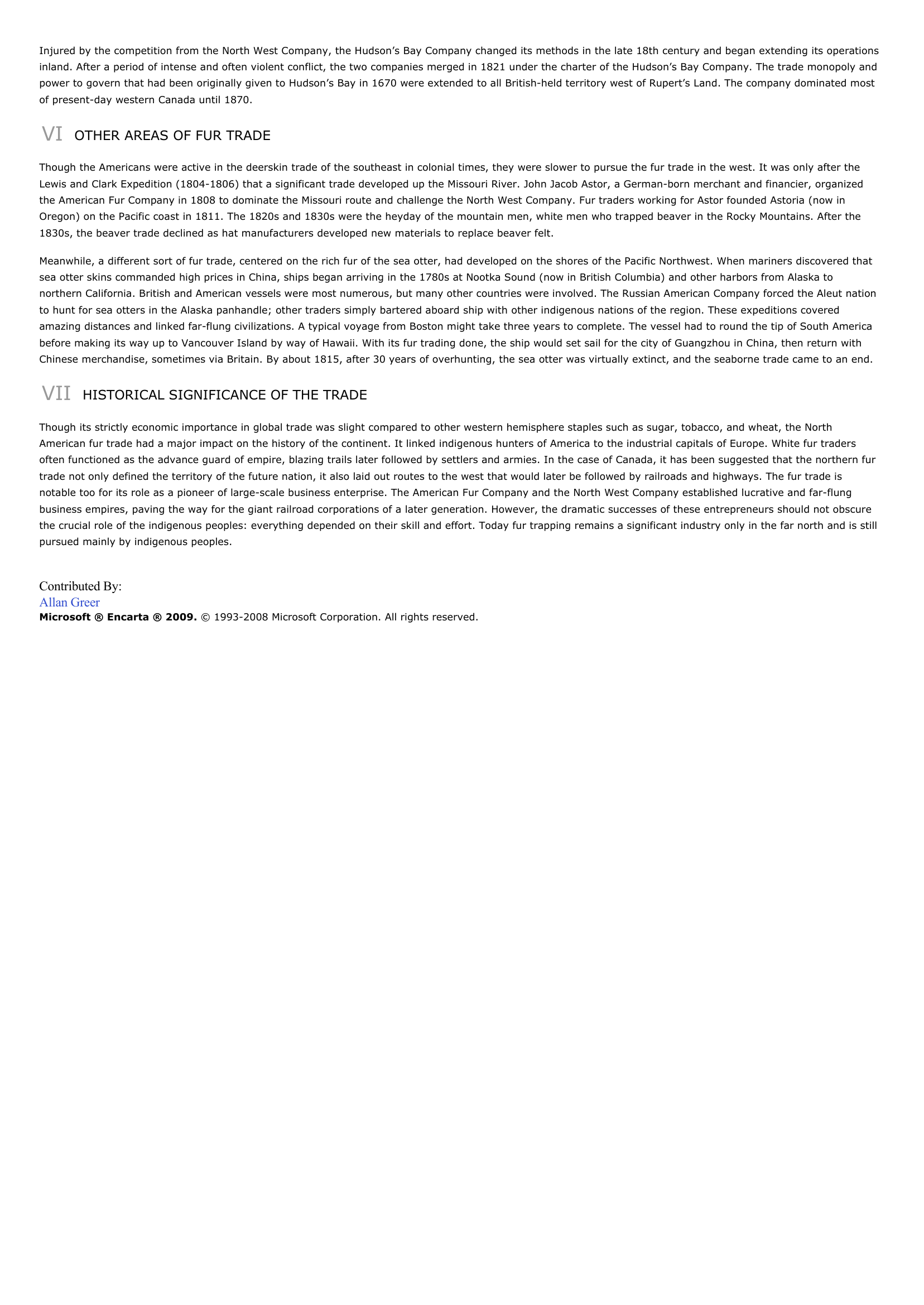Fur Trade in North America - Canadian History.
Publié le 03/05/2013

Extrait du document
«
Injured by the competition from the North West Company, the Hudson’s Bay Company changed its methods in the late 18th century and began extending its operationsinland.
After a period of intense and often violent conflict, the two companies merged in 1821 under the charter of the Hudson’s Bay Company.
The trade monopoly andpower to govern that had been originally given to Hudson’s Bay in 1670 were extended to all British-held territory west of Rupert’s Land.
The company dominated mostof present-day western Canada until 1870.
VI OTHER AREAS OF FUR TRADE
Though the Americans were active in the deerskin trade of the southeast in colonial times, they were slower to pursue the fur trade in the west.
It was only after theLewis and Clark Expedition (1804-1806) that a significant trade developed up the Missouri River.
John Jacob Astor, a German-born merchant and financier, organizedthe American Fur Company in 1808 to dominate the Missouri route and challenge the North West Company.
Fur traders working for Astor founded Astoria (now inOregon) on the Pacific coast in 1811.
The 1820s and 1830s were the heyday of the mountain men, white men who trapped beaver in the Rocky Mountains.
After the1830s, the beaver trade declined as hat manufacturers developed new materials to replace beaver felt.
Meanwhile, a different sort of fur trade, centered on the rich fur of the sea otter, had developed on the shores of the Pacific Northwest.
When mariners discovered thatsea otter skins commanded high prices in China, ships began arriving in the 1780s at Nootka Sound (now in British Columbia) and other harbors from Alaska tonorthern California.
British and American vessels were most numerous, but many other countries were involved.
The Russian American Company forced the Aleut nationto hunt for sea otters in the Alaska panhandle; other traders simply bartered aboard ship with other indigenous nations of the region.
These expeditions coveredamazing distances and linked far-flung civilizations.
A typical voyage from Boston might take three years to complete.
The vessel had to round the tip of South Americabefore making its way up to Vancouver Island by way of Hawaii.
With its fur trading done, the ship would set sail for the city of Guangzhou in China, then return withChinese merchandise, sometimes via Britain.
By about 1815, after 30 years of overhunting, the sea otter was virtually extinct, and the seaborne trade came to an end.
VII HISTORICAL SIGNIFICANCE OF THE TRADE
Though its strictly economic importance in global trade was slight compared to other western hemisphere staples such as sugar, tobacco, and wheat, the NorthAmerican fur trade had a major impact on the history of the continent.
It linked indigenous hunters of America to the industrial capitals of Europe.
White fur tradersoften functioned as the advance guard of empire, blazing trails later followed by settlers and armies.
In the case of Canada, it has been suggested that the northern furtrade not only defined the territory of the future nation, it also laid out routes to the west that would later be followed by railroads and highways.
The fur trade isnotable too for its role as a pioneer of large-scale business enterprise.
The American Fur Company and the North West Company established lucrative and far-flungbusiness empires, paving the way for the giant railroad corporations of a later generation.
However, the dramatic successes of these entrepreneurs should not obscurethe crucial role of the indigenous peoples: everything depended on their skill and effort.
Today fur trapping remains a significant industry only in the far north and is stillpursued mainly by indigenous peoples.
Contributed By:Allan GreerMicrosoft ® Encarta ® 2009. © 1993-2008 Microsoft Corporation.
All rights reserved..
»
↓↓↓ APERÇU DU DOCUMENT ↓↓↓
Liens utiles
- British North America Act - Canadian History.
- Native Americans of North America - Canadian History.
- Canadian Architecture I INTRODUCTION L'Anse aux Meadows In around ad 1000 Norse Vikings sailed from Greenland to North America and set up a village on the tip of what is now the island of Newfoundland's Great Northern Peninsula.
- North West Company - Canadian History.
- Native American Architecture I INTRODUCTION Native American Architecture, traditional architecture of the peoples of who lived in North America before Europeans arrived.



















